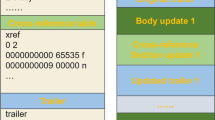Abstract
In the current digital information age, PDF417 code has become an indispensable tool in daily life because it is extensively used. By the universal use of PDF417 code applications, mobile code scanning has become an indispensable part of people’s lives. Before scanning a PDF417 code, it is extremely important to confirm the security of the two-dimensional code, thus we need to take the necessary means to authenticate the two-dimensional code. Many researchers have proposed a digital watermarking algorithm that combines binary image watermarking technology and PDF417 code technology in view of the poor anti-counterfeiting performance of PDF417 codes. These algorithms can effectively resist replication, forgery and tampering attacks. However, these algorithms are limited to the use of mobile phone applications and cannot be integrated into mobile phones, which brings inconvenience to users. Therefore, this paper proposes a watermarking algorithm for PDF417 codes which is suitable for mobile terminal detection. First, based on the characteristics of PDF417 codes, the algorithm finds the appropriate boundary position to embed the watermark information and the watermark information is used for pixel inversion. Then, the geometrically distorted image of PDF417 obtained from the mobile phone is preprocessed and corrected into a relatively standard PDF417. Finally, the watermark information is extracted by the boundary error calculation. The theoretical analysis and experimental results show that the watermark which is embedded by this method can be extracted by mobile phone.














Similar content being viewed by others
References
Chen, R., Liu, Z.Y., Jiang, Y.H., Zhang, Y.: Coding Principle and Implementation of Two-dimensional PDF417 Bar Code. IEEE (2011). https://doi.org/10.1109/ICIEA.2011.5975630
Feng X, Ji X (2009) A Blind Watermarking Method with Strong Robust Based on 2D-Barcode. International Conference on Information Technology and Computer Science. https://doi.org/10.1109/ITCS.2009.231
Liu, X.F., Li, S.M.: An adaptive chaotic encrypted binary image digital watermarking algorithm based on DCT. Int. Conf. Intell. Comput. Integrated Syst. (2010). https://doi.org/10.1109/ICISS.2010.5656801
Sheidaee A, Farzinvash L (2017) A novel image steganography method based on DCT and LSB. 2017 9th International Conference on Information and Knowledge Technology (IKT) 116–123. https://doi.org/10.1109/IKT.2017.8258628.
Wang GC, Chen S (2012) A PDF417 Angle Automatic Detection Algorithm under Complex Background. 2012 8th International Conference on Wireless Communications, Networking and Mobile Computing 1–4. https://doi.org/10.1109/WiCOM.2012.6478358.
Rao, K.L., Jagadeesh, B., Lekhamrutha, A.: A Blind approach of QR Code based color Image watermarking using DWT. I-Manager’s J. Image Process. 6, 40–45 (2019)
Niu, X.M., Huang, W.J., Wu, D., Zhang, H.: Information hiding technology based on 2d barcode. J. Sun yat-sen Univ. 43(A02), 21–25 (2004)
Wu, C.L., Lin, J.J., Li, L.M.: Study on the steganography of two-dimensional code against printing attack. Comput. Appl. Softw. 34(03), 87–92 (2017)
Rong C, Zhen-Ya L, Yan-Hu J, (2011) Coding principle and implementation of two-dimensional PDF417 bar code. 2011 6th IEEE Conference on Industrial Electronics and Applications (ICIEA). https://doi.org/10.1109/ICIEA.2011.5975630
Kim, Y.J., Lee, J.Y.: Algorithm of a Perspective Transform-Based PDF417 Barcode Recognition. Wirel. Personal Commun. Int. J. 89, 893–911 (2016). https://doi.org/10.1007/s11277-016-3171-6
Liu FY, Yin JP, Li K, Liu Q (2010) An Improved Recognition Method of PDF417 Barcode. IEEE https://doi.org/10.1109/CCPR.2010.5659332
GBT 17172–1997. 417 bar code (1997). State bureau of technical supervision of China https://www.chinesestandard.net/PDF/English.aspx/GBT17172-1997
Li JM, Zhang WH (2019) Research on Two-Dimensional Bar Coding Technology of Pdf417. DEStech Transactions on Economics, Business and Management.
Hou QZ, Dai JP, Li L, Lu JF, Chang CC (2014) Scanned binary image watermarking based on additive model and sampling. Springer Science Business Media New York.
Savakar, D.G., Ghuli, A.: Robust invisible digital image watermarking using hybrid scheme. Arab. J. Sci. Eng. 44(4), 3995–4008 (2019)
Li, K.J., Meng, F.W., Huang, Z.P., Wang, Q.: A correction algorithm of QR code on cylindrical surface. J. Phys: Conf. Ser. 1237(2), 127006 (2019). https://doi.org/10.1088/1742-6596/1237/2/022006
Lay KT, Zhou MH (2017) Perspective projection for decoding of QR codes posted on cylinders. 2017 IEEE International Conference on Signal and Image Processing Applications (ICSIPA). https://doi.org/10.1109/ICSIPA.2017.8120576
Canny, J.: A computational approach to edge detection. IEEE Trans. Pattern Anal. Mach. Intell. 8(6), 679–698 (1986). https://doi.org/10.1109/TPAMI.1986.4767851
Amiri, S.H., Jamzad, M.: Robust watermarking against print and scan attack through efficient modeling algorithm. Signal Process 29(10), 1181–1196 (2014)
Acknowledgements
This research project was supported by the National Natural Science Foundation of China (Grant No. 62062064) and the Education Department of Jilin Province (Grant No. JJKH20200511KJ).
Author information
Authors and Affiliations
Corresponding author
Additional information
Communicated by J. Dittmann.
Publisher's Note
Springer Nature remains neutral with regard to jurisdictional claims in published maps and institutional affiliations.
Rights and permissions
About this article
Cite this article
Li, D., Zhang, L. & Jin, X. An improvement for PDF417 code authentication on mobile phone terminals based on code feature analysis and watermarking. Multimedia Systems 28, 1585–1596 (2022). https://doi.org/10.1007/s00530-022-00910-0
Received:
Accepted:
Published:
Issue Date:
DOI: https://doi.org/10.1007/s00530-022-00910-0




